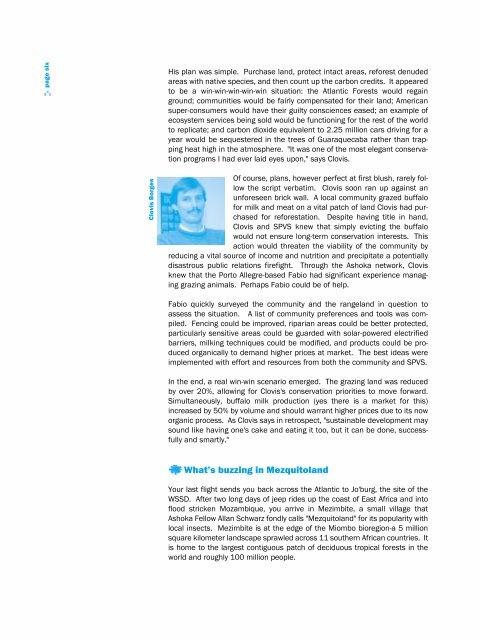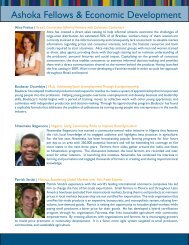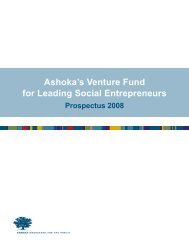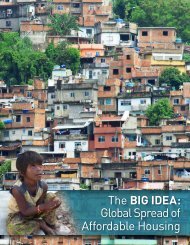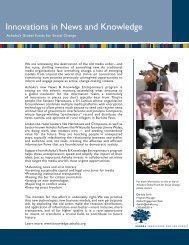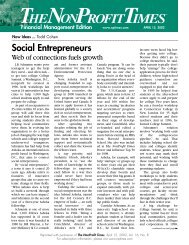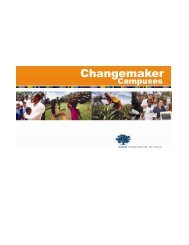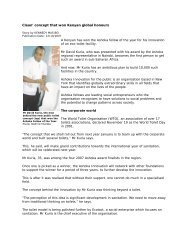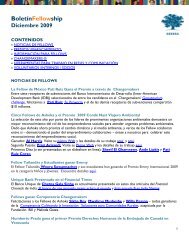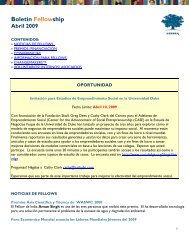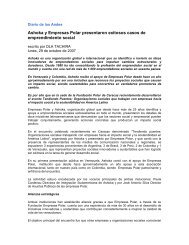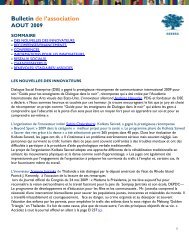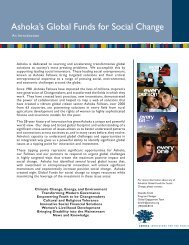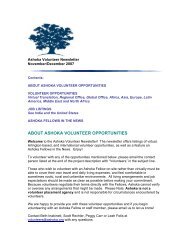Social Entrepreneurs: Doing Sustainable Development - Ashoka
Social Entrepreneurs: Doing Sustainable Development - Ashoka
Social Entrepreneurs: Doing Sustainable Development - Ashoka
Create successful ePaper yourself
Turn your PDF publications into a flip-book with our unique Google optimized e-Paper software.
page six<br />
Clovis Borges<br />
His plan was simple. Purchase land, protect intact areas, reforest denuded<br />
areas with native species, and then count up the carbon credits. It appeared<br />
to be a win-win-win-win-win situation: the Atlantic Forests would regain<br />
ground; communities would be fairly compensated for their land; American<br />
super-consumers would have their guilty consciences eased; an example of<br />
ecosystem services being sold would be functioning for the rest of the world<br />
to replicate; and carbon dioxide equivalent to 2.25 million cars driving for a<br />
year would be sequestered in the trees of Guaraquecaba rather than trapping<br />
heat high in the atmosphere. "It was one of the most elegant conservation<br />
programs I had ever laid eyes upon," says Clovis.<br />
Of course, plans, however perfect at first blush, rarely follow<br />
the script verbatim. Clovis soon ran up against an<br />
unforeseen brick wall. A local community grazed buffalo<br />
for milk and meat on a vital patch of land Clovis had purchased<br />
for reforestation. Despite having title in hand,<br />
Clovis and SPVS knew that simply evicting the buffalo<br />
would not ensure long-term conservation interests. This<br />
action would threaten the viability of the community by<br />
reducing a vital source of income and nutrition and precipitate a potentially<br />
disastrous public relations firefight. Through the <strong>Ashoka</strong> network, Clovis<br />
knew that the Porto Allegre-based Fabio had significant experience managing<br />
grazing animals. Perhaps Fabio could be of help.<br />
Fabio quickly surveyed the community and the rangeland in question to<br />
assess the situation. A list of community preferences and tools was compiled.<br />
Fencing could be improved, riparian areas could be better protected,<br />
particularly sensitive areas could be guarded with solar-powered electrified<br />
barriers, milking techniques could be modified, and products could be produced<br />
organically to demand higher prices at market. The best ideas were<br />
implemented with effort and resources from both the community and SPVS.<br />
In the end, a real win-win scenario emerged. The grazing land was reduced<br />
by over 20%, allowing for Clovis's conservation priorities to move forward.<br />
Simultaneously, buffalo milk production (yes there is a market for this)<br />
increased by 50% by volume and should warrant higher prices due to its now<br />
organic process. As Clovis says in retrospect, "sustainable development may<br />
sound like having one's cake and eating it too, but it can be done, successfully<br />
and smartly."<br />
What’s buzzing in Mezquitoland<br />
Your last flight sends you back across the Atlantic to Jo'burg, the site of the<br />
WSSD. After two long days of jeep rides up the coast of East Africa and into<br />
flood stricken Mozambique, you arrive in Mezimbite, a small village that<br />
<strong>Ashoka</strong> Fellow Allan Schwarz fondly calls "Mezquitoland" for its popularity with<br />
local insects. Mezimbite is at the edge of the Miombo bioregion-a 5 million<br />
square kilometer landscape sprawled across 11 southern African countries. It<br />
is home to the largest contiguous patch of deciduous tropical forests in the<br />
world and roughly 100 million people.


